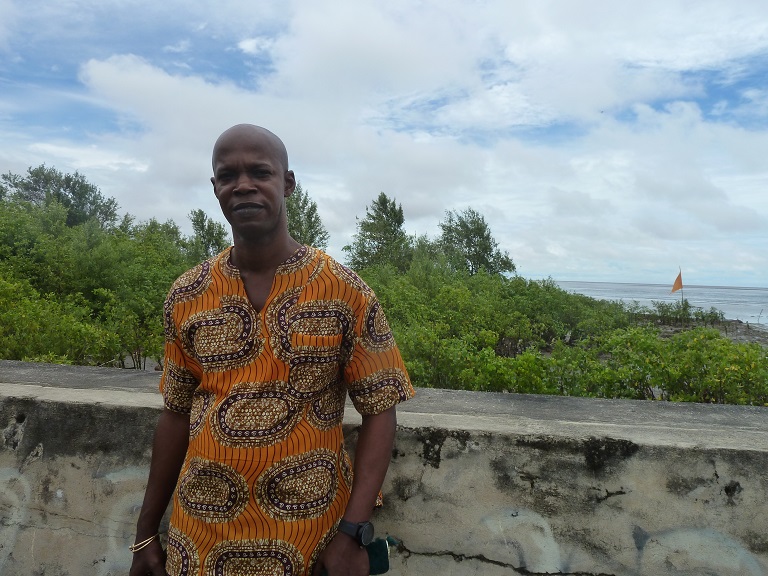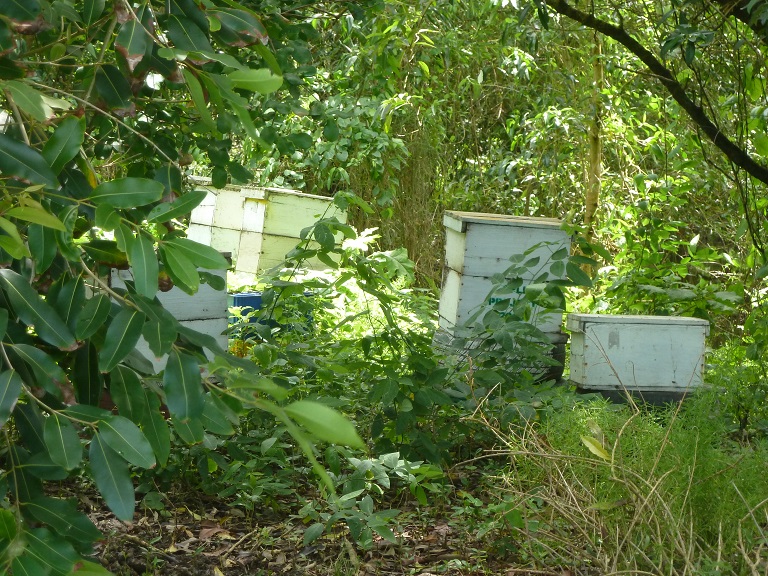- A mature mangrove tree, which can grow as high at 30 feet, acts as a buffer against the sea and storms, a filter for the water, and can chop ten times more carbon than any other plant.
- Greater seawall defense is an urgent problem in a country where portions of the coastline are nearly five feet below sea level at high tide.
- Almost 90 percent of the country’s population lives and works along Guyana’s fertile Atlantic coast, making a lack of seawall defense a potential threat to food security, livelihoods and lives.
GEORGETOWN, Guyana – When Guyana’s Mangrove Restoration Project began a few years ago, things didn’t get off to the best of starts.
“At my site at Cove and John here [on the East Coast] we planted 28,000 seedlings,” said Raymond Hinds, a local ranger. “All those seedlings washed away because of erosion.” All the careful preparation – identifying the site, recruiting locals to grow the seedlings, hiring drainage and irrigation workers to plant them – was simply swept into the Atlantic Ocean. But through this early failure, and others at different sites along the coast, lessons were learned.
“We [came to know] about the accretion and decretion cycle,” Hinds said, referring to increases and decreases in coastal sediment. “And the shift of the mud bank from one area to a next area.”
The Guyana Mangrove Restoration Project (GMRP) was launched in 2010 with funding from the EU and Guyanese government. The aim was to help build up the coastal nation’s natural sea defenses against the Atlantic Ocean – an urgent task in a country where parts of the coastline are nearly five feet below sea level at high tide. A vast seawall was constructed in the 19th century, but flooding has remained an issue and could worsen with rising sea levels. Though the seawall has been heightened and stabilizing riprap blocks added in some areas, the importance of coastal mangrove forests has become increasingly apparent.

Close to 90 percent of the country’s population lives and works along the fertile coast, meaning food security, livelihoods and lives are at stake.
Mangroves could be the answer.
“Mangroves act as a buffer,” Hinds said. “A mature mangrove tree can grow as high at 30 feet. Mangrove also chops ten times more carbon than any other plant.”
Loss and gain
In 1990, the total area of mangrove forest in Guyana was estimated at 91,000 hectares, according to Guyana’s Fifth National Report to the United Nations Convention on Biological Diversity. By 2009, this figure stood at 22,632 hectares, notes the same report. But mangrove loss is not a recent phenomena.
“We lost plenty of our mangrove trees in the 70s when we had a fuel crisis in Guyana,” Hinds said. “People would go out there and cut it for firewood.”
There are other traditional applications, too, which include using the bark of red mangrove trees for tanning leather. The bark can fetch $100 a pound, according to Hinds. The leaves of black mangrove trees can be used in cooking (the underside of the leaves contain salt crystals), and the clay around the trees’ roots can be turned into road bricks. Some communities traditionally cut the trees to gain access to the sea for fishing, or to ward off mosquitoes, which are perceived to flourish in the mangrove forests.

However, while the human impact on mangrove re-growth is well documented – such as in a 2005 country profile of Guyana by the UN’s FAO – the GMRP team realized they needed to do a lot more research concerning the impact of natural phenomena, such as coastal soil erosion.
“Some areas were planted in 2010, which we started monitoring in 2012,” said Rudolph Adams, senior monitoring officer. “We missed two years of data.”
But as the project found its feet and technical experts were brought in, better monitoring protocols were introduced and more training carried out. Now, before a site is selected, research is carried out: the section is measured using GPS and the soil elevation is checked to see if it is conducive to mangrove planting. The work doesn’t end there: measurements are carried out quarterly in the first year of planting, twice in year two, and annually thereafter.
A new start
GMRP officially ended in 2013 but was reborn as the Mangrove Restoration and Management Department within the government-funded National Agricultural Research & Extension Institute (NAREI). Today the department continues to build on lessons learned through the GMRP to ensure more successful outcomes, according to Project Coordinator Kene Moseley.
“These include restoration interventions such as construction of bamboo sediment traps and geotextile tube groynes – to trap sediments at sites that do not meet the elevation criteria for mangroves to be restored naturally,” Moseley said. “[Plus] spartina grass planting to consolidate the soil at some sites.”
Choosing the right mangroves is also important, as different varieties grow differently depending upon the location. The species that has principally been used in Guyana is Avicennia germinans, or black mangrove.
“Mostly you would find the black mangroves towards the seawards end,” Adams said. “They could take the tide and because of the roots that they have; but the white, they grow on high elevation – so you would see them more inward. Sometimes you would find the red mangrove in between but red mostly grows where you have brackish water [a mix of fresh water and sea water], where the salinity is not so high.”
So far, an estimated 142 hectares (about 350 acres) of mangrove forest has been restored along Guyana’s coastline since rehabilitation efforts began – but that only tells half the story, according to Adams.
“When we give you a figure that we would’ve restored so many hectares, that’s what we would’ve restored, but we would’ve impacted additional areas in terms of the natural generation we’ve been getting,” Adams said.
Going forward, the department’s plans for 2017 include developing a new site between the coastal towns of Lima and Devonshire Castle, northwest of the mouth of the mighty Essequibo River, which originates at the Acarai Mountains on Guyana’s southern border with Brazil and stretches up to the Atlantic Ocean.
As well as encouraging mangrove growth in the area, the work will involve vital community engagement. As at other sites, local women (often single mothers) will be paid 50 cents for each 14-inch mangrove seedling they grow. There will also be temporary employment opportunities for seedling planters and site monitors. And a permanent ranger from the surrounding area will be hired and trained to manage the site and report back to NAREI – just like Hinds was when he first came on board.
Victoria is one of the villages along the stretch of mangrove forest monitored by Hinds, famed as the first village bought by freed slaves in Guyana. The introduction of a $125,000 geo-textile tube – a structure made from permeable fabrics, which is used to ‘dewater’ sediments to tackle coastal soil erosion – is expected to bring positive results in terms of new mangrove growth. But the real success is in the village itself.

“It’s the awareness center,” Adams said. Community sensitization has been so successful in Victoria that local schools organize trips to its Mangrove Visitors’ Center (or receive school visits from the NAREI team), other communities come to the village seeking advice, and when someone spots a dump truck leaving garbage on the seawall they know to call Hinds, whose cell number can be found written along the wall.
Community involvement
As in seven other communities where mangrove restoration has taken place in Guyana, a Village Mangrove Action Committee (or VMAC) was established in Victoria to provide training in mangrove ecology, restoration and management, seedling propagation and mangrove monitoring to residents in the East Coast community. And volunteers were recruited to raise awareness about the need to protect, not destroy, the mangroves.
In return for volunteers giving up their time – and to help ensure project sustainability and a sense of community investment – the Mangrove Restoration and Management Department helps provide training and resources in alternative livelihoods – opening up opportunities for local people in honey-making, tourism and the production of artisan food products. This has led to the creation of the Mangrove Reserve Producers Cooperative Society, selling honey and condiments; the Victoria Honey House, offering honey, candles and other handmade products; the Mahaica River Tour, a bird-watching attraction funded by Caribbean-Aqua Terrestrial Solutions; and Nature’s Gift, a innovative venture by a man called Devon Gilead that produces honey, scented beeswax candles, beeswax hair food and honey soap.
There’s also the Mangrove Heritage Trail Tour which Moseley says is creating new streams of income.
“[It] provides an opportunity for community members to earn an income as tour guides, drummers and horse drivers, while visitors are educated about the importance of mangroves and the rich cultural heritage of the communities from Golden Grove to Belfield on the East Coast,” she said.
Carlotta De Jesus runs the Victoria Honey House with her husband, Colin.
“I was keeping bees on the highway and we were made to understand that the mangrove produce good honey,” she said. “So we started the aviary in between the existing mangroves.”
A part-time seamstress, De Jesus also grew mangrove seedlings (6,000 of the 28,000 that were first planted in Cove and John) and did public awareness in the local community for the GMRP.

She became so well-known for her work that she has since become a member of the local council. “When you’re doing things in the community, you have to have the community people involved,” she said.
Continued work
Although there are now regulations forbidding the cutting of mangrove trees – according to Hinds you could spend three months in prison pay a fine of about $150 – the NAREI team understand that legislation has to be combined with outreach and education. So when local fishermen cut trees to get their boats into the open water, there is some flexibility.
“They have to do their trade,” concedes Adams. “So we wouldn’t chastise them for that, we allow them to clear the area so that their boat can go through. We’re more community-friendly because it’s a vast forest and we can’t monitor it on our own. So we’re hoping that persons to assist in that regard.”
In return for minimal cutting of mangroves, local fishermen can also enjoy a rich supply of shrimp and small fish, which live between the mangroves – as well as crabs, found on the large mud banks.

Despite some successes, many issues remain for the mangrove department to tackle: from wandering livestock grazing on seedlings and squatting, to littering and private landowners cutting back mangroves for aquaculture or agriculture schemes. Moseley also notes it can be difficult to keep community volunteer groups actively engaged, and that further knowledge about planting techniques is needed.
“There is a need for better understanding of the influence of mud bank movement on mangroves,” Moseley said. “This will allow for proper planning of the most appropriate interventions, which will increase success rates.”
More collaboration with neighboring Suriname and French Guiana may help, as both countries are engaged in projects to restore their mangrove sea defenses. And, of course, the people who live alongside Guyana’s mangroves will continue to share their expertise.
A few minutes’ walk from the seawall back in Victoria’s coastline, where fledgling mangrove seedlings battle the tides, a man selling vegetarian ital food to passersby offers his analysis on the previous failure: “This don’t work by planting alone, this work with nature…I wrong or right?”
Banner image: House construction alongside the seawall in Felicity, Guyana. Photo by Carinya Sharples for Mongabay.
Carinya Sharples is a Guyana-based foreign correspondent. You can find her on Twitter at @carinyasharples
FEEDBACK: Use this form to send a message to the author of this post. If you want to post a public comment, you can do that at the bottom of the page.
